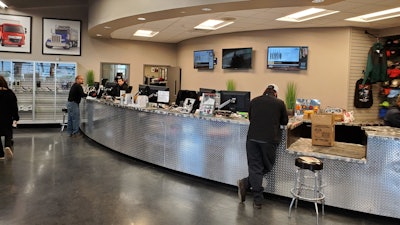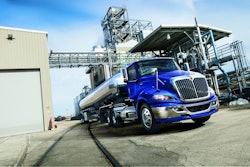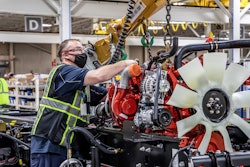
Rush Enterprises Inc., which operates the largest network of commercial vehicle dealerships in North America, announced that for the second quarter ended June 30, 2021, the company achieved revenues of $1.316 billion and net income of $58.0 million compared with revenues of $1.003 billion and net income of $16.8 million in the quarter ended June 30, 2020.
“We are proud of our team for achieving impressive financial results in the second quarter, which were largely driven by the continued nationwide economic recovery and widespread activity throughout most market segments we support. In addition to healthy demand for new and used trucks and aftermarket products and services resulting from the continued economic recovery, our continued focus on expense management also contributed to our strong results this quarter,” says W.M. “Rusty” Rush, chairman, CEO and president, Rush Enterprises.
Component supply chain issues are the biggest concern in the industry, as they are directly affecting new truck production, with the timing of some new truck deliveries now stretching well into 2022, Rush says.
“However, demand remains strong, and manufacturers plan to increase production as component parts become more readily available. Industry-wide aftermarket sales have also been impacted by supply constraints, but we believe our parts inventory management has mitigated those impacts on our business and we expect our aftermarket sales will continue to improve throughout 2021,” he says.
“We believe our financial results will be strong for the remainder of 2021 as we continue to navigate this unusual market marked by both unprecedented supply constraints and strong customer demand. We will continue to manage expenses company-wide, while we continue adding personnel to meet market demand,” Rush says. “It is important that I recognize our employees for their steadfast commitment to our company and support of our customers, which allowed us to have such a great quarter.”
Operations
Aftermarket products and services
Aftermarket products and services accounted for approximately 62 percent of the company’s total gross profit in the second quarter of 2021, with parts, service and collision center revenues reaching $445.5 million. The company achieved a quarterly absorption ratio of 129.1 percent in the second quarter of 2021, compared with 110.2 percent in the second quarter of 2020.
“Our parts and services revenues were up 18 percent in the second quarter of 2021 compared to the same quarter last year, which we attribute to the overall recovery of the national economy,” says Rush.
“Our parts sales are back to pre-pandemic levels, with healthy activity in a variety of market segments, especially leasing, refuse and over-the-road customers and from independent service centers. However, parts sales are beginning to be impacted by supplier constraints. To date, we have been able to mitigate most of the impact of supplier constraints with the size of our parts inventory at our nationwide dealership network. Service revenues are improving at a slower pace, which is due in part to staffing issues common in the industry, along with supply chain issues. We are actively hiring parts personnel and service technicians throughout our network and remain focused on promoting our Xpress Services preventive and contract maintenance offerings, which enable us to bring in business and build long-term relationships with new customers,” he says.
“As we look ahead, supply constraints are expected to continue to negatively impact the industry through 2021. Our parts management technologies help us adjust to current market dynamics and effectively manage our nationwide parts inventory. Further, we are piloting “final mile” route optimization software to improve efficiency in our parts deliveries. With the economy expected to remain strong, we believe our aftermarket revenues will continue to increase for the remainder of 2021,” says Rush.
Commercial vehicle sales
New U.S. Class 8 retail truck sales totaled 58,844 units in the second quarter of 2021, up 63.3 percent over the second quarter last year, according to ACT Research. The company sold 2,954 new Class 8 trucks in the second quarter, an increase of 58.3 percent compared with the second quarter of 2020, which accounted for 5.0 percent of the new U.S. Class 8 truck market.
“In the second quarter, our new Class 8 truck sales were up significantly compared to the second quarter of 2020, due to healthy activity from a wide variety of market segments, including vocational, construction and over-the-road customers as well as strong sales of stock trucks. Our results were again driven by the continued economic recovery and strong freight rates throughout the country,” Rush says.
“As we look ahead, component supply issues will likely continue to impact new Class 8 truck production through the third quarter or longer, pushing out the delivery dates for new trucks and contributing to a historically high backlog. Depending on our manufacturers’ ability to ramp up production capacities, we believe our third quarter new Class 8 truck sales will be consistent with our second quarter results and expect new Class 8 truck sales will accelerate later this year and into 2022,” he said.
New U.S. Class 4 through 7 retail commercial vehicle sales totaled 63,426 units in the second quarter of 2021, up 26.1 percent over the second quarter last year, according to ACT Research. The Company sold 2,825 new Class 4-7 medium-duty commercial vehicles in the second quarter of 2021, an increase of 21.1 percent compared to the second quarter of 2020, representing 4.5 percent of the U.S. Class 4-7 commercial vehicle market.
“In the second quarter, our Class 4-7 new commercial truck sales were up significantly year-over-year, largely due to the nation’s overall economic strength, as well as increased activity from our lease and rental and food service customers who continue to recover from the effects of the pandemic. However, component supply chain issues also continue to cause production shutdowns for some of the medium-duty manufacturers we represent. Looking ahead, we believe Class 4-7 truck production capabilities will not improve as quickly as Class 8 truck manufacturing, which will negatively impact Class 4-7 truck sales in the third quarter. That said, demand is strong, and we are well positioned to take advantage of every sales opportunity,” Rush says.
The company sold 2,094 used commercial trucks in the second quarter of 2021, an increase of 18.4 percent over the second quarter of 2020.
“Used truck sales continued to be exceptionally strong across all market segments in the second quarter, driven primarily by the limited availability of new Class 8 trucks. Used truck values remain historically high as well, though we expect some softening may occur later this year if new truck production increases. While it is becoming more challenging to maintain a desirable supply of used trucks, we believe used truck demand will remain healthy, and our third quarter sales will be on pace with our second quarter results,” says Rush.
Strategic growth, expanded customer support through Cummins JV.
In June, Cummins Inc. and Rush Enterprises signed a Letter of Intent for Cummins to acquire a 50 percent equity interest in Momentum Fuel Technologies. The joint venture will produce Cummins-branded natural gas fuel delivery systems for the commercial vehicle market in North America and offer aftermarket support through Rush Truck Centers dealerships and Cummins distributors, which will be able to service both the engine and the fuel delivery system.
“We believe in the long-term viability of natural gas vehicles. The current economic and infrastructure challenges associated with the adoption of Class 8 electric vehicles, existing and future emissions regulations and the environmental benefits of vehicles operating on renewable natural gas will make natural gas vehicles a practical choice for many of our customers for the foreseeable future. This joint venture will further enable us to keep customers’ trucks up and running across the country through Cummins’ and Rush Truck Centers’ broad portfolio of aftermarket solutions and robust support network throughout North America,” Rush says.
The joint venture is expected to close later this year.
Financial highlights
In the second quarter of 2021, the company’s gross revenues totaled $1.316 billion, a 31.3 percent increase from gross revenues of $1.003 billion reported in the second quarter of 2020. Net income for the second quarter of 2021 was $58.0 million compared to net income of $16.8 million in the second quarter of 2020.
Aftermarket products and services revenues were $445.5 million in the second quarter of 2021, compared to $377.6 million in the second quarter of 2020. The Company delivered 2,954 new heavy-duty trucks, 2,825 new medium-duty commercial vehicles, 472 new light-duty commercial vehicles and 2,094 used commercial vehicles during the second quarter of 2021, compared to 1,866 new heavy-duty trucks, 2,333 new medium-duty commercial vehicles, 254 new light-duty commercial vehicles and 1,768 used commercial vehicles during the second quarter of 2020.
The company’s lease and rental revenues increased by 7.2 percent in the second quarter of 2021, compared to the second quarter of 2020. Rush Truck Leasing operates 45 PacLease and Idealease franchises with more than 8,800 trucks in its lease and rental fleet and more than 1,300 trucks under contract maintenance agreements.
During the second quarter of 2021, the Company repurchased $4.2 million of its common stock pursuant to its stock repurchase plan. In addition, the Company paid a cash dividend of $10.0 million during the second quarter of 2021.
“With our continued focus on growing our business while carefully managing expenses, our balance sheet and cash position remain strong,” Rush says.











